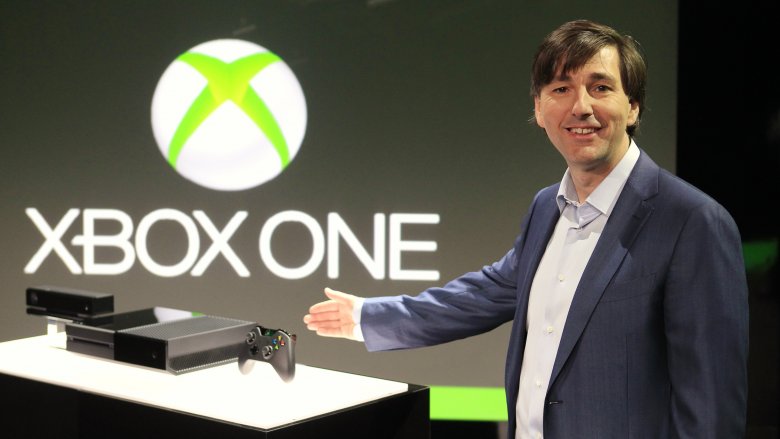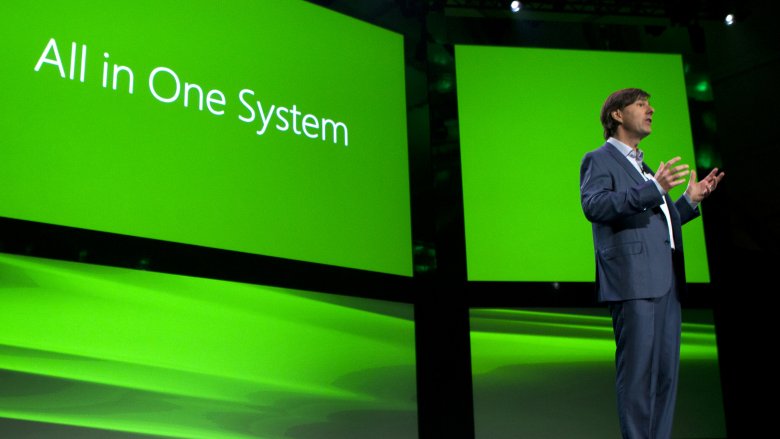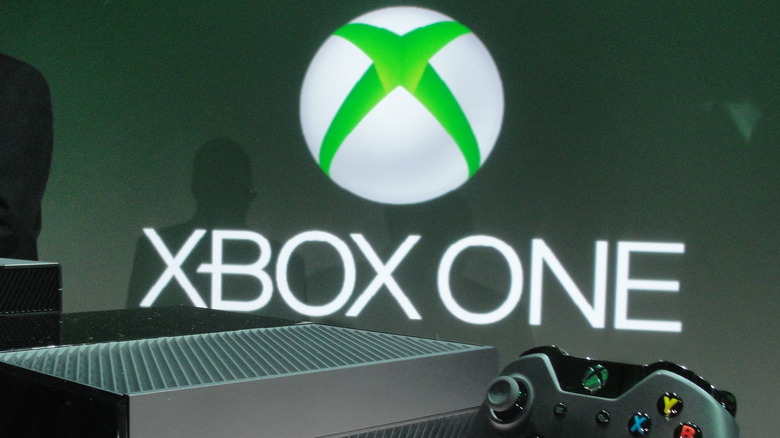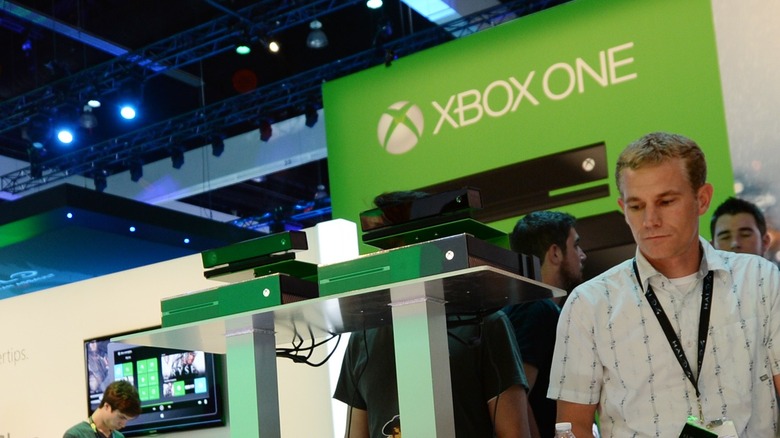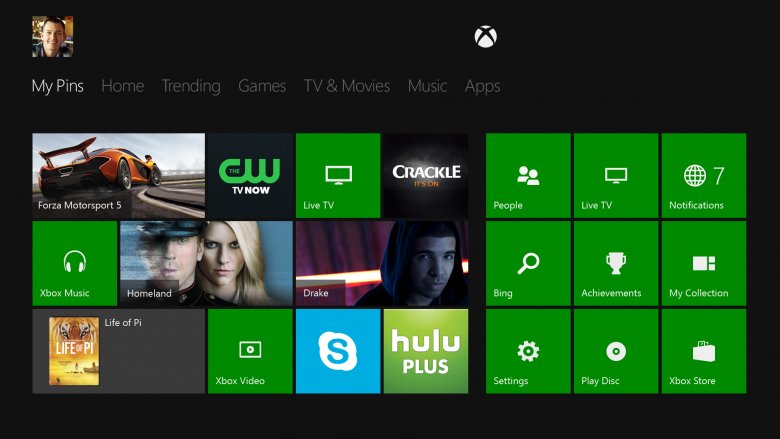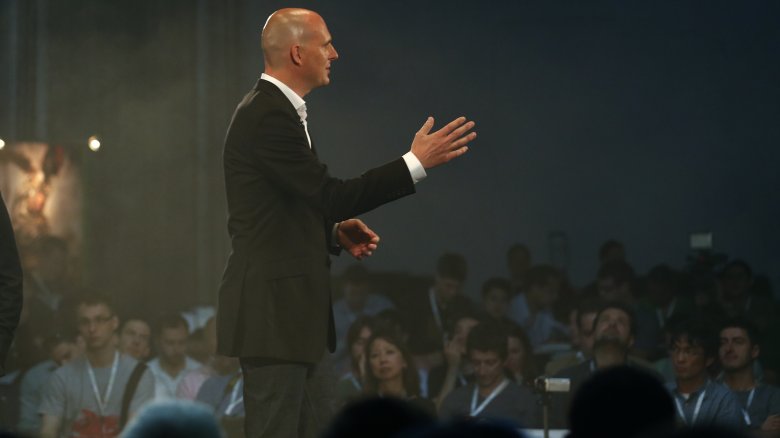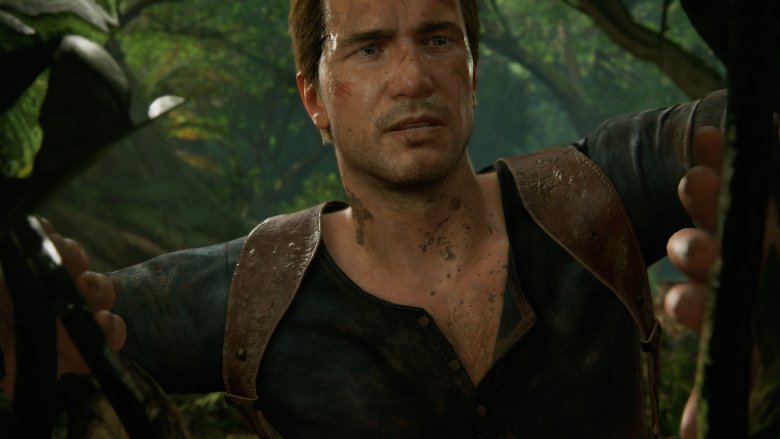Everything Microsoft Did Wrong With The Xbox One
Microsoft did very well for itself during the seventh generation of video game consoles, as the Xbox 360 went on to become a strong seller around the world. The company's Xbox Live service dominated multiplayer gaming with megahits like Halo 3 and Gears of War. Meanwhile, the Xbox 360 became the console that most reviewers tested games on, and many other games or DLC came to the console first in timed exclusive windows (usually because Microsoft paid the publisher to make it so).
All around, the Seattle tech giant went into the eighth generation of consoles in 2013 with the wind at its back. The new Xbox, jokingly called the 720 before its announcement, was expected to be a heavy challenger to the new PlayStation, if not an outright generation winner. But when the new console was finally revealed as the Xbox One, nothing went Microsoft's way. In the end, the new Xbox One got off to a rocky start. Some of the issues were avoidable, others were innovations that came too early, and still others were just plain bad ideas. Any one or two of them might not have been too bad, but all together, Microsoft found itself facing the full might of the gaming community's wrath. Here's everything Microsoft did wrong with the Xbox One.
Emphasis on home entertainment
The Xbox 360 was always more than just a game console: it could play DVDs, it could run apps like Netflix or Hulu, and it could even be used as a music player. For the new Xbox One, Microsoft decided to expand on that notion so far that they tried to reposition the device as more of a home entertainment hub than a mere gaming system. At the console's reveal event, Microsoft spent much of its time unveiling non-gaming features, such as the ability to receive a cable TV signal, and to either play TV directly or splitscreen alongside another app. It could even record live TV and offered a navigation menu for channels. Meanwhile, it could connect to speakers and be used as a stereo replacement as well.
There was comparatively little emphasis on games. While Remedy Entertainment's Quantum Break was announced at the event (with a non-gameplay trailer), the rest of the gaming reveals were all the usual list of suspects: Call of Duty, Forza, and FIFA. Not bad games by any means, but they were the expected ones. Did anybody really think that Call of Duty wouldn't be on the new Xbox? Microsoft found it hard to drum up excitement over what people already knew.
But while the game reveals fell flat, the "home entertainment hub" approach simply fell on its face. None of the TV features interested anybody, especially since the cable integration would only work in the US anyway. To Microsoft's surprise, what gamers wanted was a game console, not a glorified DVR (with less functionality than the DVR they already had). The de-emphasis on the Xbox's core strength rubbed a lot of people the wrong way, and left a clear opening for Sony to attack.
An odd name
The original Xbox console was simply called the Xbox. Everyone expected the follow-up to be called the Xbox 2, but it ended up being named the Xbox 360. Microsoft has never publicly stated why this was, but the suspicion is that Microsoft didn't want to put something with a "2" in its name against the PlayStation 3. So when the new Xbox was in development, gamers were left to guess what it would be called. The Xbox 720 was a popular assumption, but nobody knew for sure.
But it immediately became confusing, since most gamers already referred to the original Xbox as the "Xbox 1" (to distinguish it from the 360). It was also strange to go from the number 360 to the number One. The whole idea seemed a bit confused, which didn't exactly inspire confidence in Microsoft's plans.
The Kinect was mandatory
The Kinect originally debuted as an optional accessory for the Xbox 360. An innovative and sophisticated camera and sensor array, the Kinect could read your body's movements without any other hardware necessary. At launch, it was a big hit. While gamers never took to it with enthusiasm, it became a fantastic workout tool. Plus, its built-in microphone was a great way to use voice controls on your system.
Understandably, Microsoft was excited by the possibilities that the Kinect afforded. In particular, they liked the fact that no one else had anything like it. Unfortunately, they got a little too excited. For the Xbox One, Microsoft made the Kinect a mandatory accessory. Every single console would ship with one, and the system would not function–at all–unless a Kinect was attached.
This had a number of consequences. For one thing, it made the console more expensive than it would've been without a Kinect in the box. For another, gamers who didn't like the Kinect–and there were a lot–saw its mandatory inclusion as a negative, not a neutral. Finally, the Kinect was meant to allow people to activate the system with nothing but their voice, by saying "Xbox on." But this also meant that there
was a camera and microphone active all the time in their living room–or, potentially, bedroom. The Kinect ended up being a controversy that hobbled sales and excitement for the Xbox One, rather than heralding the "future of gaming" as Microsoft tried to promote it.
In the end, Microsoft was forced to reduce the Kinect to an optional extra instead of a mandatory feature, which effectively killed all support for the camera in the industry. Very few Kinect-enabled games have been made since.
Always online
As part of the overall Xbox One announcement, Microsoft declared that the system would require a constant connection to the Internet. What did this actually mean? Well, it was complicated. Different features required different levels of connectivity, but even a single-player-only game would require a connection to Microsoft's servers at least once every day. If it could not do so, the Xbox One would brick itself until it could.
This led to a huge backlash among the gamer community. Some players don't live in areas with constant or reliable Internet access; some players lived where there was no access at all, such as a remote military base or rural areas in some countries. Granted, the vast majority of likely Xbox One buyers would have had a constant Internet connection anyway, but Microsoft's callous and confusing attitude towards the whole incident came off as uncaring.
Worse, Sony saw the vulnerability and exploited it. At their own E3 conference debuting the PlayStation 4, the Japanese company proudly announced that no Internet connection would be required. The Xbox One was left looking out of touch.
Sharing games and buying used games
As they developed the Xbox One, Microsoft believed that the future of physical media was dim. In the future, people would just buy games directly from a digital store, download it to their hard drives, and never see a disc in the first place. Microsoft decided to get ahead of the curve and introduce some features that a digital-only world could provide. Most notably, a game tied to a specific Xbox Live account could be downloaded and played on multiple machines, so if you had two houses for instance, your game would be available at both, all the time. This was a feature long-available on PC that would finally be coming to consoles. Neat!
Did Microsoft do this right? Of course not.
Microsoft didn't provide any replacement for a disc's simple ability to be shared between friends. In the Xbox One's proposed system, nobody could borrow a game from anybody–ever. Worse, this meant a complete and total halt to the entire used games market, in which players were free to sell their game discs to a friend or a secondhand retailer. Players vocally declared their support of both: they loved sharing games with friends, and many consumers bought their games used. Microsoft gave no real explanation for why these features were being removed, leaving gamers to assume this was all meant as a way to funnel more money towards Microsoft's digital store, as well as to keep more money flowing directly to game studios, who don't see any profits from used game sales.
Once again, Sony saw the opening, and seized it. At their E3 press conference, they not only affirmed the PlayStation 4's commitment to lending and used games, but put out the above, much-shared video to show, step-by-step, just how to do it on the PS4.
Uncoordinated messaging
Does all of this sound confusing? It did to gamers, too. And, apparently, to Microsoft themselves. In interview after interview, the Seattle giant seemed to have no ready answers for any of the foreseeable and valid questions around these issues. Even later attempts to clarify their answers only made things even worse. Yet again, this was in stark contrast to Sony's performance: all of their messaging around the PlayStation 4 was clear and to the point, and no major controversies or questions emerged around the device's features.
Microsoft is an enormous company with a large Public Relations department, and a lot of experience in both messaging and crisis management. The fact that the Xbox One communications could be so scattered, unclear, unhelpful, and even damaging to the brand was even more extraordinary because of that experience. Maybe it was unfair, but the fact that a company like Microsoft was so off its game made the issues appear even worse than they already were.
Less powerful than the PlayStation 4
But for all the bad messaging and poor community management, it would all be worth it in the end if the Xbox One was the superior product, right? Well, we'll never know, because in many ways the Xbox One proved to be less superior than Microsoft thought. The console's primary competition was Sony's PlayStation 4, which turned out to be a lot better in a lot of ways.
While they both came with a 500GB hard drive, the PS4 allowed players to swap it out for a bigger hard drive if they wished. The Xbox One had no equivalent ability, though an owner could plug in an external drive. Both consoles featured 8GB of RAM, but Sony's machine had advanced GDDR5 RAM as opposed to the older DDR3 on the Xbox One. With other specs, such as the GPUs, being similar, that gave the decisive advantage to the PlayStation 4 over the Xbox One.
And for what it was worth: the PS4 even managed to be smaller, too. Oof. Confusing messaging on the less capable product was a disaster for Microsoft.
More expensive than the PlayStation 4
When the seventh generation of consoles released, Sony priced the PlayStation 3 above the Xbox 360 because the Japanese company believed it had made the superior device. Whether or not that was true, the Xbox 360's lower price point ended up shifting a lot of units, forcing Sony to drop its system down to comparable pricing not long after. Given this history, you might think Microsoft would have learned that price matters. Then again, given everything else you've just read in this article, you might think Microsoft would screw this up, too. You'd be right the second time.
At launch, the Xbox One was $499, whereas the PlayStation 4 was $399. Part of this was due to the mandatory inclusion of the Kinect–Sony simply didn't have to price for a similar hardware feature. If the Xbox One had been clearly superior in some way, perhaps the extra price would have been worth it. If the two consoles were equal, that price difference would be a disaster. In this case, the PS4 had both better specs and a less controversial debut, making its cheaper cost the final nail in the coffin for the Xbox One's launch.
The result of all of this was a huge backwards step for Microsoft and the Xbox brand in general. The PlayStation 4 leapt out to a massive lead in the eighth generation. Where the Xbox 360 had once been reviewers' console of choice to play most multiplatform games, these days most reviewers will test a game on the PlayStation 4. Where the Xbox had once gotten the lion's share of timed exclusive content, now many major content additions go to the PlayStation 4 first.
But to be fair to Seattle, the Xbox in its current form is really quite good. The upgraded Xbox One S, devoid of constant connectivity or a mandatory Kinect, is a small, quiet, capable console. And the newly released Xbox One X is the most powerful console currently available on the market. It's just a shame that Microsoft got so much so wrong in the early days of the Xbox One's existence.

